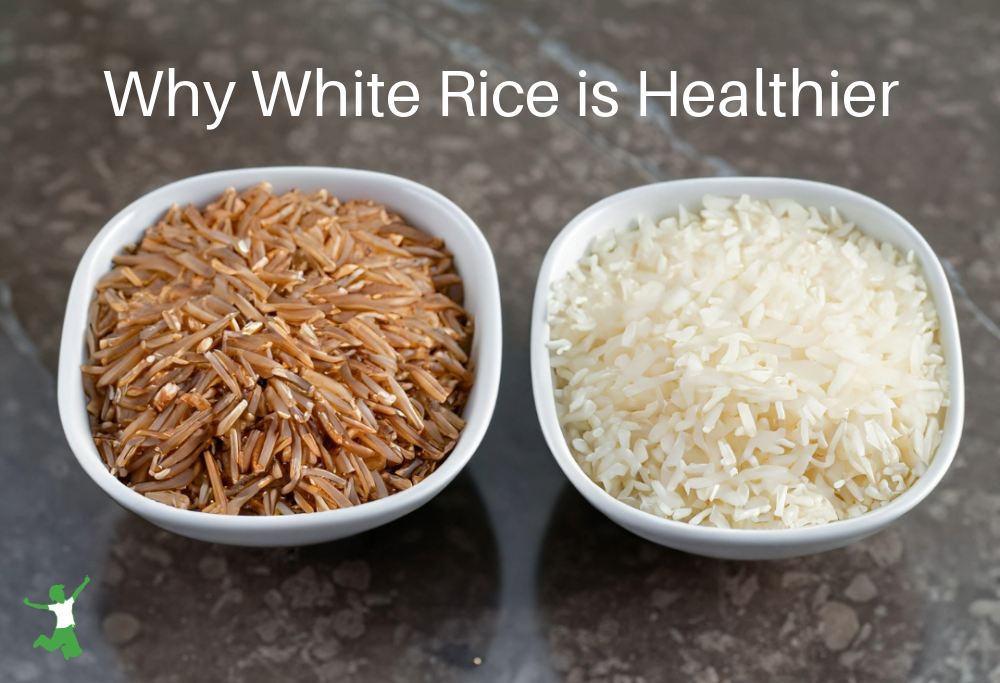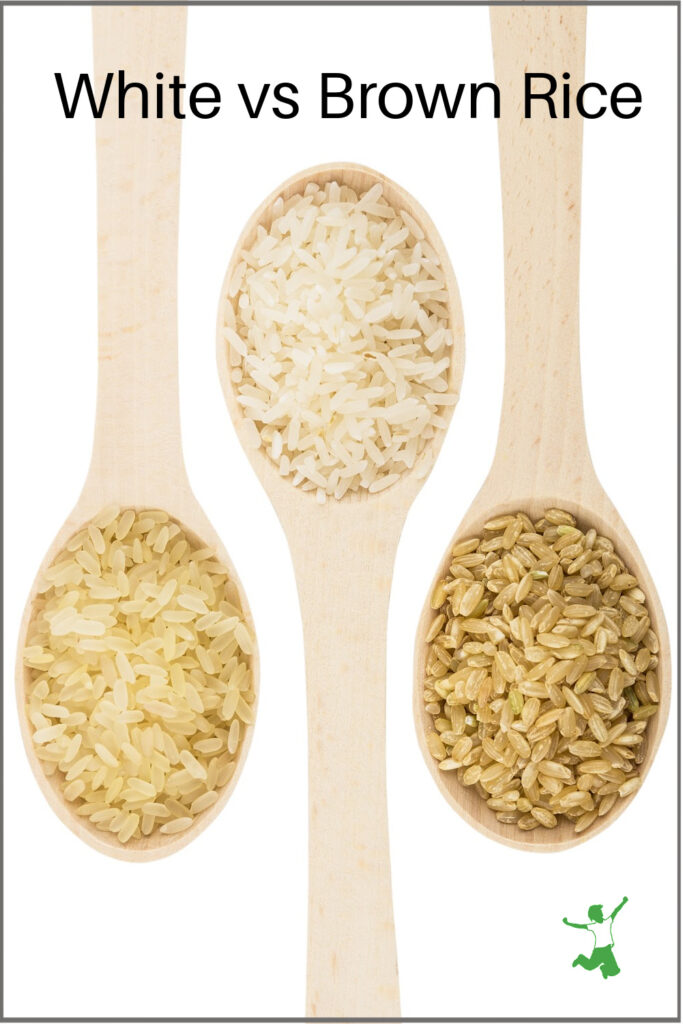The reasons white rice is healthier than brown rice as determined by research as well as which type traditional societies preferred consuming.

My article and video on healthy Chinese food drew some comments from readers who questioned my choice of rice.
Why was I using white rice vs brown? Isn’t brown rice the healthier choice, after all?
Ok, I’ll spill the beans, rice. Here are my reasons …
The truth is, neither my husband nor myself have ever enjoyed brown rice (although we love the nutty flavor and digestibility of wild rice).
Every time we eat brown, it just seems to not sit very well in our stomachs.
Even when it is sprouted or soaked before cooking, it, well, uh, sits like a brick for lack of a better word.
Why Some People Should Eat White Rice
White rice just seems to digest a whole lot better for us. That to me was reason enough to choose it over the brown rice.
We were also advised by an Ayurvedic MD back in the 1990s to stick with white basmati rice. This recommendation clinched the decision.
You are what you digest, after all – not necessarily what you eat!
End of story? Well, not quite.
Rice Fiber in Brown Harms a Compromised Gut
A few years back at the annual Wise Traditions Conference, I became familiar with a compelling book called Fiber Menace.
The author writes extensively about the dangers of a high-fiber diet as it pertains to a menu loaded with whole grains as pushed by the misguided Food Pyramid.
In other words, folks who eat a bowl of All Bran every morning to keep the bathroom visits regular are unknowingly ripping their insides to shreds.
The basic premise of Fiber Menace is that grain fiber plays a leading role in many gut-related ailments including colon cancer.
When I first learned of this information, my preference for white rice over brown rice started to make more sense.
Perhaps the brown rice didn’t digest that well because of all that fiber?
Chalk one up for the white rice.
White Rice Far Lower in Phytic Acid
A second piece of information came from author Ramiel Nagel.
In his book, Cure Tooth Decay, he writes about the devastating effects of phytic acid in the diet. Phytic acid is a very powerful antinutrient and blocker of mineral absorption in the gut.
Mr. Nagel identifies brown rice as very high in phytic acid.
What’s more, soaking brown rice does not reduce phytic acid by much at all!
Polished Rice is the Ancestral Form
Ramiel also maintains that the traditional method for preparing brown rice is never to eat it whole (with only the husk removed).
Rather, ancestral societies pounded brown rice in a mortar and pestle to polish it by removing the outer bran layer. This is the primary source of the phytic acid.
Nagel goes on to point out that experiments have shown that the milled and polished rice that results from this pounding process, has the highest mineral absorption.
In short, mineral absorption from whole brown rice is much less than white polished rice. This is because the phytic acid in the bran which is not reduced much by soaking, greatly interferes with the absorption process.
What About Arsenic?
A big issue with arsenic contamination in rice has emerged in recent years. Some folks have responded by no longer eating rice at all.
This is an overreaction, in my view.
Clean rice is definitely available if you know what to look for.
This article on how to avoid arsenic in rice details what to do. While soaking brown rice barely moves the needle on phytic acid, soaking white rice before cooking removes nearly all the arsenic!
Another option is to parboil white rice before using fresh water for a full cook if you don’t have time to soak.
Is White Rice Better Than Brown?
So it seems that brown rice is not necessarily a healthier choice than milled white rice.
Black or red rice would fall into the same category.
Obviously, whether you choose one or the other is a personal preference, but I hope this information helps you sort through the decision with a bit more clarity.
As for me and my family, we will be sticking with white basmati and jasmine rice (white basmati rice is more nutritious than plain white rice).
I currently buy this brand of rice in 25-pound bags as the most economical and high-quality choice.
Observation clued me in many years ago that brown rice was not something that was sitting well in my stomach or my husband’s.
As the years go by, more research is coming forth to indicate that this decision was the right way to go after all.
Do you eat white rice or brown rice in your home? Why or why not?

References
(1) Fiber Menace
(2) Living with Phytic Acid
More Information
Macrobiotic Diet and Extreme Vitamin D Deficiency
Tiny Teff Grains Deliver Big on Nutrition
How to Make Perfect Yellow Rice (Arroz Amarillo)
Millet: Healthy or Not?
Do Whole Grains Cause Cavities?








I don’t see that Sarah’s article has any relevant scientific support for her conclusions except a single data point, her family. There is a mountain of data from bonafide scientists using solid scientific methods suggesting the opposite. Thanks Sarah, but I opt for valid, scientific methodology that support the health value of all the colored rice (thus unmilled) over white rice including the sprouted varieties. But ultimately, it may boil (no pun intended) to personal taste, which is not science.
1) Arsenic is not really all that harmful on the scale of “bad things to be in food”. It would occur naturally in several foods/plants if only wild humans were eating them with industrialization and chemical companies having never been invented.
2) The healthiest and best rice is purple rice, NOT white rice.
3) If brown rice “has the bran removed”, doesnt that turn it into (dun dun sun)… white rice?!!
4) Additionally there are many many types of white rice if it was actually true that only brown and white rices exist. Some types of white rice smell like plastic in dry form and some types of white rice taste amazing after you consider the fact that white rice is already expected to be a bland and boring food, so, in comparison.
Thanks for this article … I also felt intuitively that brown rice was not a choice for me and my husband. For almost two decades, we have eaten solely white basmati rice and loved it. I will withstand the pressure to switch to brown rice from various sources!
Sarah…do you soak your white basmati rice before cooking it?
Yes, I do. Here’s why. https://www.thehealthyhomeeconomist.com/arsenic-in-rice/
Yep, stop eating bread. O did soon lost 20lbs. Felt weakened took supplement’s. But something was missing. I too have the same problems with brown rice. I notice tonight I had bags of emergency food and white rice was there too. I cooked it up added ( ORGANIC )paprika, cinnamon, parsley after I cooked it. I let it stand 10 minutes. I felt energy emerging from within my body. I then looked on the INTERNET. White rice is the best. I never hardly eat it. Going to now though.
P.S. This is the article that got me interested in fermented brown rice:
“The result is a texture more like white rice, and a much more digestible grain, but healthier than eating white rice. The brown rice ‘flavor’ is even a bit more muted.”
thenourishingcook.com/soaked-brown-rice/
In fermented brown rice, the phytic acid can apparently be reduced by 96%: wholehealthsource.blogspot.com/2009/04/new-way-to-soak-brown-rice.html
There are a lot of articles on fermenting brown rice. I’ve been doing this and I really like the taste, especially cooked in a clay pot.
I just wanted to relay what my Nutritionist passed on to me, that was passed on to him from a Chinese friend. “You people are so stupid. We just dye the white rice brown so we can sell it for a higher price here in North America.” Ever seen a chinaman eat brown rice. Nope. never. DAH.
My .02…we’re all dying from the day we are born. Doesn’t always matter how ‘healthy’ (and what defines ‘healthy’ eating seems to change over time) we live because even those who do all the things ‘right’ still find their way onto the rolls of people who’ve died of heart disease, cancer, diabetes, etc. Moderation in all things is key. To that end, I eat foods I enjoy. I dislike the taste of brown rice and, through experience, I don’t do well with a high fiber diet. So I eat white rice. Some will say it’s bland…no, it actually does have a taste and one I prefer of brown.
I know I am years too late for this post! But just wanted to chip in with something in case it could help others.
For years I was having terrible stomach issues, pain and bloating etc- I’m young, i eat healthy but i couldn’t find anything to help at all, including medication, until a nutritionist that i met at a fitness bootcamp told me to switch from white bread, pasta and rice to brown. Within a week or so I felt a million times better- and still do. Obviously if the brown gives you stomach problems definitely avoid it but if you have IBS (like i do) give it a try. I did feel more bloated at first before it got better right enough- worth it though!!